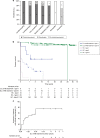Efficacy and safety of D,L-3-hydroxybutyrate (D,L-3-HB) treatment in multiple acyl-CoA dehydrogenase deficiency
- PMID: 31904027
- PMCID: PMC7200590
- DOI: 10.1038/s41436-019-0739-z
Efficacy and safety of D,L-3-hydroxybutyrate (D,L-3-HB) treatment in multiple acyl-CoA dehydrogenase deficiency
Abstract
Purpose: Multiple acyl-CoA dehydrogenase deficiency (MADD) is a life-threatening, ultrarare inborn error of metabolism. Case reports described successful D,L-3-hydroxybutyrate (D,L-3-HB) treatment in severely affected MADD patients, but systematic data on efficacy and safety is lacking.
Methods: A systematic literature review and an international, retrospective cohort study on clinical presentation, D,L-3-HB treatment method, and outcome in MADD(-like) patients.
Results: Our study summarizes 23 MADD(-like) patients, including 14 new cases. Median age at clinical onset was two months (interquartile range [IQR]: 8 months). Median age at starting D,L-3-HB was seven months (IQR: 4.5 years). D,L-3-HB doses ranged between 100 and 2600 mg/kg/day. Clinical improvement was reported in 16 patients (70%) for cardiomyopathy, leukodystrophy, liver symptoms, muscle symptoms, and/or respiratory failure. D,L-3-HB appeared not effective for neuropathy. Survival appeared longer upon D,L-3-HB compared with historical controls. Median time until first clinical improvement was one month, and ranged up to six months. Reported side effects included abdominal pain, constipation, dehydration, diarrhea, and vomiting/nausea. Median D,L-3-HB treatment duration was two years (IQR: 6 years). D,L-3-HB treatment was discontinued in 12 patients (52%).
Conclusion: The strength of the current study is the international pooling of data demonstrating that D,L-3-HB treatment can be effective and safe in MADD(-like) patients.
Keywords: D,L-3-hydroxybutyrate treatment; fatty acid oxidation; inborn error of metabolism; ketone bodies; multiple acyl-CoA dehydrogenase deficiency.
Conflict of interest statement
The authors declare no conflicts of interest.
Figures



Similar articles
-
Enantiomer-specific pharmacokinetics of D,L-3-hydroxybutyrate: Implications for the treatment of multiple acyl-CoA dehydrogenase deficiency.J Inherit Metab Dis. 2021 Jul;44(4):926-938. doi: 10.1002/jimd.12365. Epub 2021 Feb 15. J Inherit Metab Dis. 2021. PMID: 33543789 Free PMC article.
-
Favorable outcome after physiologic dose of sodium-D,L-3-hydroxybutyrate in severe MADD.Pediatrics. 2014 Oct;134(4):e1224-8. doi: 10.1542/peds.2013-4254. Epub 2014 Sep 22. Pediatrics. 2014. PMID: 25246622
-
D,L-3-hydroxybutyrate treatment of multiple acyl-CoA dehydrogenase deficiency (MADD).Lancet. 2003 Apr 26;361(9367):1433-5. doi: 10.1016/S0140-6736(03)13105-4. Lancet. 2003. PMID: 12727399
-
Neonatal-onset multiple acyl-CoA dehydrogenase deficiency (MADD) in the ETFDH gene: A case report and a literature review.Medicine (Baltimore). 2020 Sep 11;99(37):e21944. doi: 10.1097/MD.0000000000021944. Medicine (Baltimore). 2020. PMID: 32925727 Free PMC article. Review.
-
A systematic review of late-onset and very-late-onset multiple acyl-coenzyme A dehydrogenase deficiency: Cohort analysis and patient report from Taiwan.Neuromuscul Disord. 2021 Mar;31(3):218-225. doi: 10.1016/j.nmd.2021.01.006. Epub 2021 Jan 13. Neuromuscul Disord. 2021. PMID: 33589341
Cited by
-
Recurrent abdominal pain, vomiting, velvet-like changes in the small intestine in a patient with multiple acyl-CoA dehydrogenase deficiency: a case report.Transl Pediatr. 2021 Jan;10(1):183-187. doi: 10.21037/tp-20-253. Transl Pediatr. 2021. PMID: 33633951 Free PMC article.
-
Recurrent metabolic alkalosis following ketone body treatment of adult mitochondrial trifunctional protein deficiency: A case report.JIMD Rep. 2022 Jun 25;63(5):407-413. doi: 10.1002/jmd2.12309. eCollection 2022 Sep. JIMD Rep. 2022. PMID: 36101817 Free PMC article.
-
Hmgcs2-mediated ketogenesis modulates high-fat diet-induced hepatosteatosis.Mol Metab. 2022 Jul;61:101494. doi: 10.1016/j.molmet.2022.101494. Epub 2022 Apr 12. Mol Metab. 2022. PMID: 35421611 Free PMC article.
-
Electron transfer flavoprotein and its role in mitochondrial energy metabolism in health and disease.Gene. 2021 Apr 15;776:145407. doi: 10.1016/j.gene.2021.145407. Epub 2021 Jan 13. Gene. 2021. PMID: 33450351 Free PMC article. Review.
-
Treatable inherited metabolic disorders causing intellectual disability: 2021 review and digital app.Orphanet J Rare Dis. 2021 Apr 12;16(1):170. doi: 10.1186/s13023-021-01727-2. Orphanet J Rare Dis. 2021. PMID: 33845862 Free PMC article. Review.
References
-
- Frerman FE, Goodman SI. Chapter 103: defects of electron transfer flavoprotein and electron transfer flavoprotein-ubiquinone oxidoreductase: glutaric acidemia type II. In: Valle D, Beaudet AL, Vogelstein B, editors. The online metabolic and molecular bases of inherited disease. New York: McGraw-Hill; 2014.
-
- Olpin SE. Implications of impaired ketogenesis in fatty acid oxidation disorders. Prostaglandins Leukot Essent Fatty Acids. 2004;70:293–308. - PubMed
-
- Bouteldja N, Andersen LT, Moller N, Gormsen LC. Using positron emission tomography to study human ketone body metabolism: a review. Metabolism. 2014;63:1375–1384. - PubMed
-
- Rinaldo P, Matern D, Bennett MJ. Fatty acid oxidation disorders. Annu Rev Physiol. 2002;64:477–502. - PubMed
-
- Bonham JR, Tanner MS, Pollitt RJ, et al. Oral sodium 3-hydroxybutyrate, a novel adjunct to treatment for multiple acyl CoA dehydrogenase deficiency. J Inherit Metab Dis. 1999;22(Suppl 1):101.

